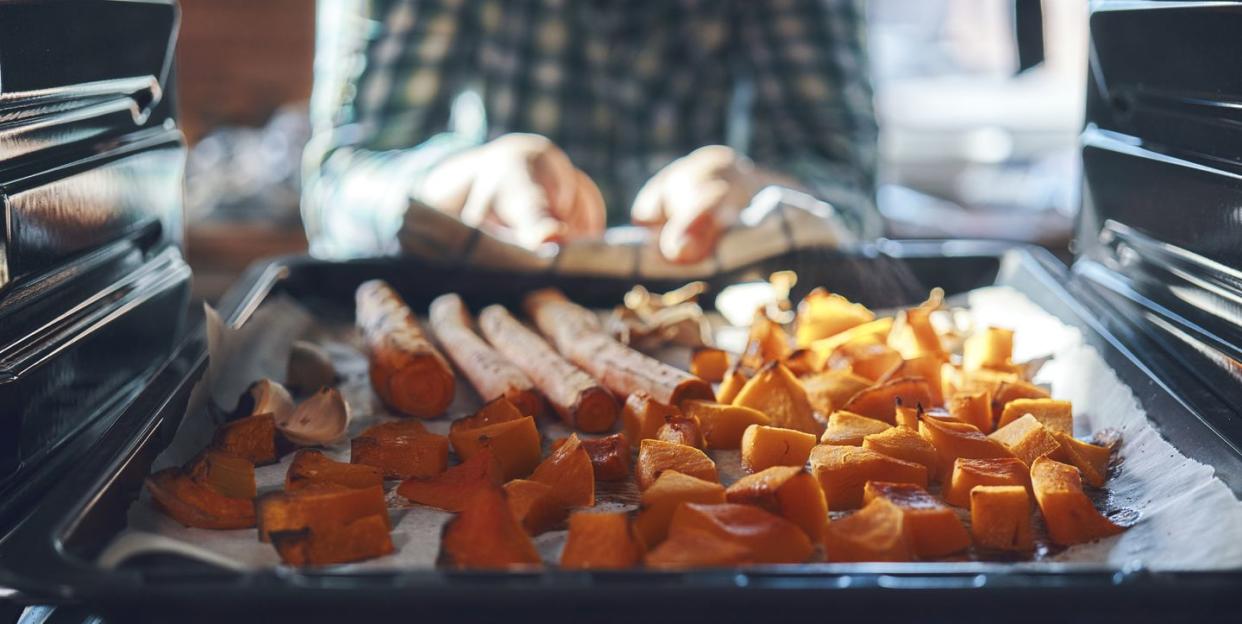Why You Shouldn't Wait for Fall to Eat More Pumpkin

First, a reminder: Pumpkin is a type of produce, not just an ingredient in scented candles. And even better than that: It’s an ultra nutritious one, too! One cup of pumpkin contains more vitamin A than a cup of kale, more potassium than a banana, and more fiber than 1?2 cup of quinoa. Here’s the nutrient lowdown on this fall favorite:
Pumpkin Nutrition Facts
Serving Size: 1 cup, cubed
30 calories
0.1 g fat
0 mg cholesterol
1 mg sodium
8 g carbohydrates
0.6 g fiber
3.2 g sugar
1.2 g protein
197% DV vitamin A
17% DV vitamin C
11% DV potassium
5% DV vitamin B-6
4% DV iron
3% DV magnesium
2% DV calcium

What are the health benefits of pumpkin?
Even though you can find it in canned form at any time of year, this trendy fall food is often forgotten for what it really is: a super high-quality and versatile vegetable.
The fiber keeps you energized. One cup of canned pumpkin has about 7 grams of fiber (about 20% of the recommended daily amount), whereas kale has a little less than 3 grams. While both have a place on your plates, the fiber content of pumpkin will fill you up, help stabilize blood sugar, and keep your energy up throughout the day.
The minerals help your heart. Pumpkin is loaded with blood pressure-regulating minerals like potassium, magnesium, and iron. They're necessary for providing oxygen to red blood cells. Surprisingly, one cup of pumpkin packs 14% of your daily value for potassium, whereas one banana has 12%.
The antioxidants boost immunity.Pumpkin is packed with beta-carotene, the precursor to vitamin A — an important antioxidant for visual acuity and skin integrity — as well as vitamins C and E, also important antioxidants for repairing your body’s cells from damage. Diets rich in antioxidants and potassium are also linked to helping reduce your risk of cancer and heart disease.
Is pumpkin fattening?
No, since cubed pumpkin contains only 0.1 grams of fat per 1-cup serving. Pureed pumpkin has slightly more at about 0.7 grams per cup, but the squash predominately provides good-for-you carbohydrates — not to mention all of those other beneficial vitamins and minerals.

Can eating pumpkin help you lose weight?
Definitely, as one cup of canned pumpkin provides a mere 83 calories. It's a smart ingredient swap for cheese or cream, which can help you cut back on calories and saturated fat in your recipes. Pumpkin also contains plenty of filling fiber, which will keep you fuller, longer and may aid in weight-loss efforts. In the spirit of making more of your meals produce-based, this is an easy one to put into practice.
Is canned pumpkin also good for you?
Yes! It doesn’t have to be fresh to get the same benefits. Unlike many other fruits and veggies, pumpkin is still loaded with nutritional benefits all year round in its canned form. One cup of canned pumpkin is vitamin- and mineral-rich, not to mention super-versatile. I love mixing ? cup of canned pumpkin into plain, low-fat Greek yogurt with cinnamon, nutmeg, and a drizzle of honey for a protein-rich snack that also satisfies my seasonal sweet tooth.

Here are some other handy ways to use more canned pumpkin:
Sauces: Substitute pumpkin for half the cheese in a sauce and add a little extra garlic, onion, or even a tablespoon or two of Parmesan. The pumpkin will add more creaminess without sacrificing flavor.
Dips: Combine pumpkin and Greek yogurt or cottage cheese with cinnamon, pumpkin pie spice, and a sprinkle of graham cracker.
Breakfast: Making waffles, pancakes, muffins, or any type of baked good? Add pumpkin puree. The beauty of pumpkin is in its versatility, since you can use it in both sweet and savory meals and snacks.
What about pumpkin seeds?

Pumpkin seeds are filled with potassium, magnesium, zinc, and iron. They pack a super-satisfying combo of about 6 grams fiber and 7 grams protein per 1.5-ounce pack, which makes them a great snack for kids and adults alike. This combo of nutrients makes you feel fuller, longer.
TIP: Make roasted pumpkin for dinner and keep the seeds to season and roast for snacks and toppings.
But what about pumpkin spice?

There’s a strange phenomenon that happens between Labor Day and Black Friday, in which supermarkets, menus, and even drugstores are suddenly riddled with an influx of pumpkin spice–flavored products. They include everything from coffee to muffins to ice cream to cereal to even dog treats. But since not all pumpkin spice products are created equal, here are some guidelines on what to look:
Choose products that actually have pumpkin as the first or second ingredient. For yogurts, ice cream, baked goods, and snack bars it’s a must; for cereals and spreads, a few ingredients down is okay on occasion. So long as the first ingredient is a real food and not a sneaky name for sugar or a synthetic "protein blend," you’re good to go.
Look for as few ingredients and grams of sugar as possible. A single digit for grams of sugar per serving is always a good gauge. Dairy- and fruit-containing products may go a little higher since these contain naturally occurring sugar. (Aim to cap yogurt at 12 grams per serving.)
Skip daily sugary beverages. Yes, that does include the pumpkin spice latte. My go-to alternative? Add 2 tablespoons of half and half to your regular cup of coffee and pumpkin pie spice to your heart’s content; sweeten as you normally would; and serve with a cinnamon stick for a festive but lower-calorie treat.
You Might Also Like
